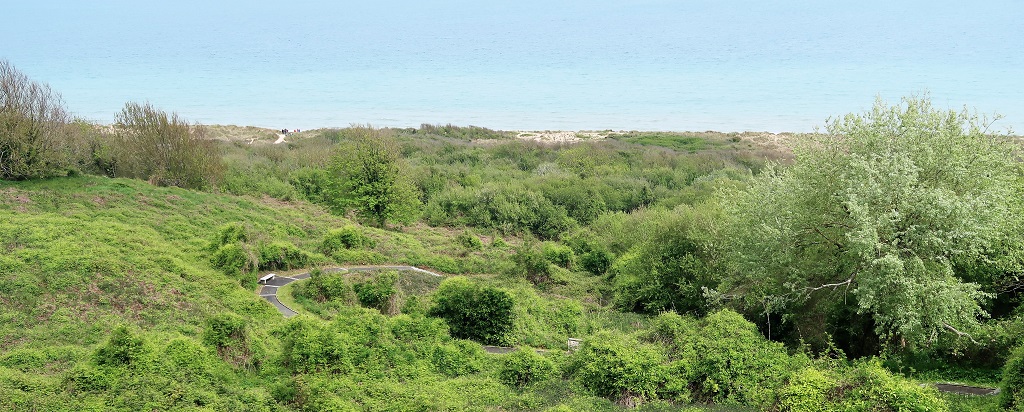We slept very well in our massive guest room at Manoir de la Riviere. Arising to another grey day with a steady breeze, a wonderful breakfast awaited us in the breakfast room. Two other couples were staying with at the B&B besides us. One couple was German and the other couple traveling with their son was from the Netherlands. Of course, they both spoke French, and of course we did not. No matter, they were very gracious and switched to English. Tom was pleased to see a small quiche in front of him. The typical French breakfast of chocolate croissants and cheese is just not enough to get his body moving. The quiche was surrounded by homemade rolls and brioche, fresh fruit, a selection of cheeses, and of course…chocolate croissants. The American coffee was also greatly appreciated. Isabelle had put out quite a spread for breakfast.
The German couple were heading to their next destination, while the Dutch trio had almost the same plan as us. Well, there was just one minor difference – They would use bikes and we would drive our Fiat.
As mentioned earlier in the blog, driving in France was very easy. The Fiat was a perfect car for us because it had storage for the suitcase, good gas milage, and was extremely roomy! Roomy you ask? Well Tom drives a Fiat 500 at home and it is much smaller than the model we had for the trip. Remember, most rentals are manual transmission vehicles. If you do get an automatic, be prepared for a major price difference.
The museum encompasses over 80 acres and over 2 miles of tunnels to be explored. We decided not to enter the fenced in encampment but walked the perimeter looking at some of the artifacts and bunkers.
For more info on the debate regarding the Maisy Battery here is a start: Maisy Battery Debate
Pont-du-Hoc was our next stop. Memorialized in the movie, the Longest Day, this point sits 100 feet above the sea and provided a great observation post for the events unfolding around them.
Initially, thought to be the location of powerful 155mm canons it became an important strategic goal on day one of the invasion. Army Rangers scaled the cliffs under heavy fire to capture Pont-du-Hoc, only to find no heavy artillery located there. Many of the bunkers remain and one can enter these solid concrete structures. We could not imagine the noise level inside these concrete rooms on the morning of 6 June. It should be noted that none of these bunkers had a pad which would support a 155mm canon. Hence, the Maisy Battery debate.
Janet popped out of one bunker to get a look from the German perspective.
After seizing the bunkers on top of the cliff, they had to defended themselves from multiple counter attacks. Of the 225 rangers who climbed this deadly vertical terrain, only 90 remained on 9 June when reinforcements arrived.
The landscape looks like the moon. Craters made by shelling from the sea and aircraft bombing has left Pont-du-Hoc pocketed with grass filled holes.
Tom, who many think his hobby is cutting grass, was blown away by a robotic all-terrain vehicle that cuts grass. A man controlled the device with a joystick as it traversed up and down the scared earth eating grass. He decided he NEEDS one of these lawnmowers for the farm back home.
From Pont-du-Hoc to Omaha beach is roughly 9 kms by car. The Omaha landing zone is 10 kms long and lies at the foot of three different villages, Vierville-sur-Mer, Saint-Laurent-sur-Mer, and Colleville-sur-Mer. The last being the location of the American Cemetery.
Driving to the first town, Vierville-sur-Mer, we found the poles alongside of the road honored the fallen. These banners continued the whole length of the beachfront. So many honored – So many to be remembered.
Driving down to the beachhead the tide was high and reached all the way to the seawall. The first monument encounter had special meaning to us. It memorializes the 29th Division 116th regiment of the National Guard. The unit was formed from mostly Virginia boys. This group was part of the first wave that landed at Omaha Beach and suffered heavy casualties.
Trying to reach the top of the dunes at Vierville-sur-Mer, Company A of the 116th hit the beach at dawn under heavy fire. By the end of the day there were only 18 survivors of 235 men of Company A remaining.
We continued down the road that parallels the beach through Saint-Laurent-sur-Mer. Banners of heroes still lined the road with signs that retold the story.
We arrived at Coleville sur Mer and parked along the sea wall. The tide seemed even higher than it was earlier as the water slapped across the rocks. Very little beach was visible for miles. We sat on the steps and stared out into the English Channel.
Protruding out of the sea is a sculpture created by the artist Anilore Banon, which she named “Les Braves”
In the sculptor’s words, this is what expressed in her work:
The Wings of Hope
So that the spirit which carried these men on June 6th, 1944, continues to inspire us, reminding us that together it is always possible to change the future.
Rise, Freedom!
So that the example of those who rose against barbarity, helps us remain standing strong against all forms of inhumanity.
The Wings of Fraternity
So that this surge of brotherhood always reminds us of our responsibility towards others as well as ourselves.
On June 6th, 1944, these men were more than soldiers, they were our brothers.
It was now time to go pay our respects to the men who lay in the soil above Coleville sur Mer. A short drive up the hill and past more hero banners hanging on roadside polls, we made our way to Normandy American Cemetery. It is here where over 9000 soldiers now rest.
As we arrived at the cemetery, we could see buses and more cars than we had experienced on vacation to date. Located high on a hill, overlooking the sea, the markers of brave men stand in a straight line from any viewing angle. They seem to be neverending.
On many of the stones are symbols of a soldier’s religion etched with the names that have begun to fade, but not the memory of what they accomplished here in Normandy in the summer of 1944. Some lie unidentified and known only to God.
One section was roped off, and as we walked the grounds a gentleman escorted a family to a specific gravesite where they spent time with a loved one who had fallen.
May they all rest in peace.
We spent a few minutes in the chapel on the grounds in quiet reflection. The day had a very emotional impact on both of us.
Neither one of us had the emotional strength to visit the tourist center and take in the exhibits. The reality of the invasion was before us. No film or exhibit could enlighten us more than the visual markers before us on what those summer days of 1944 cost in life.
Leaving the Normandy American Cemetery, the sun had come out. It was a beautiful day overlooking the sea and our flag waved in a gentle breeze.
Returning to our car we set course for Bayeux. This adventure would take us back in time 1000 years. We would not escape the ugliness of war, but we would learn of another battle that changed history in 1066. But first, lunch was in order. Once again, we were pushing the magic 2 pm time where no food would be available.
Now mastering the French parking meter system, we pulled into a parking lot downtown Bayeux and walked across the street to the closest brasserie in sight. Tom decided to return to his Alsatian heritage and go with a dish from that region with a glass of Riesling. Janet stayed in Normandy with a crab and avocado salad and enjoyed a Chablis with her meal.
Our afternoon began in the Cathedral, which is in the old section of town. This gothic cathedral was consecrated in 1077, but not completed until the 19th century. Portions had to be rebuilt in the 12th century due to fire.
The beauty of the sanctuary was filled with colors from all the stain glass and the quiet was calming. Here in Bayeux, it was the British who captured the city and there were plaques honoring those freedom fighters on the walls.
It is in this church where the Tapestry of Bayeux was displayed to teach the people of the story of William the Conquer and the Battle of Hasting. Harold, the brother-in-law of King Edward the Confessor, and William the Duke of Normandy and Edwards first cousin would fight for the crown. As Edward was dying, Harold came to Normandy to give the news to William. Harold also took an oath that he would be remain loyal to William when he ascended to the throne on the death of King Edward the Confessor. He betrayed his oath and instead claimed the crown of England for himself. The battle that followed would change history for all time. Upon Edwards death, the last Anglo-Saxon King would rule Great Britain. The House of Wessex fell, and the Normans would be the first of many to rule the island nation. (OK enough history – Thank You Mrs. Simpson – 4th Grade St Mary’s Alexandria, VA)
I cannot show pictures of the tapestry because no photos were allowed in the museum where it now is displayed. The tapestry is a piece of embroidery that tells a story in almost comic character format. It is over 200 feet long and 20 inches wide. Every panel tells the story of William and Harold that leads to the Battle of Hastings. The text is in Latin, but the handwork in the drawings tells the story. I will refer you to Wikipedia for a panel by panel description of the story: Bayeux Tapestry
It is a beautiful piece of art, and I am sorry no pictures.
Bayeux deserves more time than we gave it. However, it was time to get on the road. We walked around town a little more before heading back to Manoir de la Riviere.
Arriving back at Gérard and Isabelle’s home we immediately begin to unwind. They have a beautiful and tranquil location which is so close to so much history, yet it is very quiet.
Janet made some tea and relaxed in the sunlight reading, while Tom took in the surroundings.
There was much to do around the farm and with the clearing of the weather, Gérard was a busy man. The fields needed to be sprayed, and with the sun setting so late he would miss a wonderful dinner prepared for us by Isabelle. But before dinner we enjoyed more of the sunlight chatting with the family from the Netherlands on their adventure. Isabelle arrived with a smile and popped a cork of a bottle of bubbly, and we toasted to friends and Normandy.
Dinner was served in the family dining room and was a wonderful rustic chicken dish. The house wine was a Bordeaux from Fronsac and paired magnificently with the meal.
Well, it is not really their house, but hey if someone is going to put your name on a bottle you may as well claim it. The three of us laughed and told stories, and as we were finishing up dessert, Gérard came to the table. It was after 10 pm and still light outside and a farmer’s work was done. He was hungry and we were tired, so we said good night. Tomorrow is Paris!

































No comments:
Post a Comment